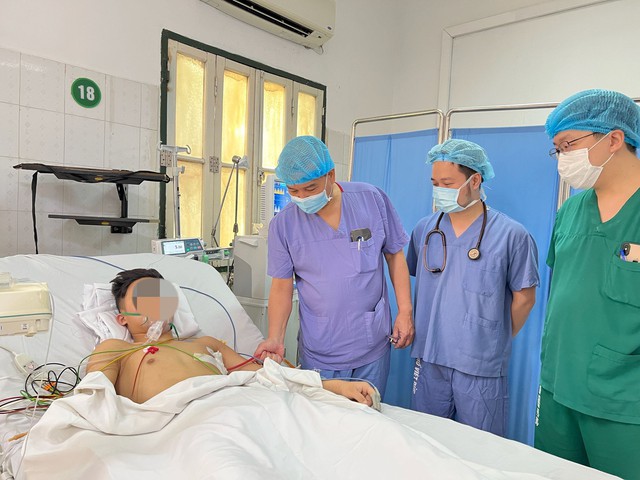Saving a young man life for a complex multi-traumatic due to motorcycle accident
26/06/2023 14:47
The patient was diagnosed with multi-traumatic shock due to Grade 3 injury at the isthmus of thoracic aorta associated with left pleural effusion, abdominal trauma, Grade 2 splenic rupture, bladder contusion, and pelvic fracture.
Viet Duc University Hospital has received a patient M.V.L (male, 17 years old) who had a motorbike traffic accident and was transferred from a lower-level hospital, in a state of chest pain with a diagnosis of multiple injuries: closed chest trauma, abdominal trauma, pelvic trauma and suspecting the aortic artery injury.
Immediately, the patient was examined by doctors, underwent CT scan, confirmed the diagnosis of multi-traumatic shock due to Grade 3 injury of the isthmus of thoracic aorta associated with left pleural effusion, abdominal trauma, Grade 2 splenic rupture, bladder contusion, and pelvic fracture.
Being aware of the complicated injuries and the high risk of death of the patient, the doctors have decided to temporarily treat with preservation of the abdominal and pelvic injuries, priority to the endovascular intervention (stent graft) on emergency for thoracic aorta. The patient was transferred to the cardiovascular intervention room still alert but pale with rapid pulse, irritability, and severe chest pain.
The patient underwent the intervention for stenting one covered stent-graft/intravascular graft from the ascending femoral artery to the pseudoaneurysm/descending aortic at isthmus injury location, with a window opening for the left subclavian artery.
After the procedure, the patient was drained the left haemothorax for about 500ml of old blood. At the moment, the patient is able to be self breathing, hemodynamically stable, well controlled the intra-abdominal injuries.

Doctors examine and check Mr.M.V.L .
Dr. Nguyen Tung Son, MD, MSc – Cardiovascular and Thoracic Center, Viet Duc University Hospital informed: “Aortic trauma is very severe and rare, mostly in the multi-complex trauma. If not treated at all, the risk of death in the first 6 hours is 24%, and up to 50% in the first 24 hours for major trauma. This is a rare disease in the past, but now with the popularity of imaging techniques, most serious injuries – especially accelerated injuries (high-speed walking, high falls, high-speed collisions) are subjected to multi-slice computed tomography to screen for diagnosis which helps in early detection of lesions and treatment planning”.
Previously, for aortic injury, there were only conservative medical treatments for mild Grades (types I, II) and surgery indicated for severe (types III, IV). An open thoracic surgery, using an extracorporeal circulatory machine, was aimed at stopping the heart beating, then cutting and replacing the vascular segment in the chest. This is a severe surgery with a high mortality rate associated with paralysis, and a prolonged postoperative recovery time.
With the development of modern medicine, in the last 10 years, doctors have not used surgery but applied endovascular interventions, stenting the stent-graft, also known as endovascular grafting. All instruments are as small as the tip of a pen and threaded through the leg vessel through the femoral artery to the upper chest. A stent graft (intravascular graft) can be opened and cover the entire body when in place. Without open surgery, the patient is able to be recovered faster, and the hospital stay is shorter.
Assoc. Prof. Dr. Nguyen Huu Uoc, MD. PhD- Director of the Cardiovascular and Thoracic Center, shared that at Viet Duc University Hospital, a special technique has been developed in recent years for the intervention of the aortic arch such as opening the window technique: Use an electric pen to open the hole in the stent body before the intervention to create a blood supply window for the left subclavian artery – where the endovascular graft will be covered during the intervention. The patient does not have to undergo the artery bypass graft surgery or re-vascularize the artery while maintaining blood flow to the subclavian artery. Especially in young patients who need to use their hands in heavy labor, it reduces the risk of complications of spinal cord paralysis, vertebral artery thrombosis and paralysis of the legs after stenting.
To date, the thoracic aortic stent-graft technique has been routinely performed at Viet Duc University Hospital, both under the elective intervention and on emergency. This medical facility also conducts the most endovascular intervention for thoracic aortic injury in Vietnam, with nearly 60 cases. In addition, the technique of using an electric pen to open a hole in the stent body before intervention to create a blood supply window has been performed since 2019 with nearly 40 cases of aortic pathology, bringing many outstanding advantages to patients.











